2015 NISSAN PATHFINDER oil pressure
[x] Cancel search: oil pressurePage 387 of 506
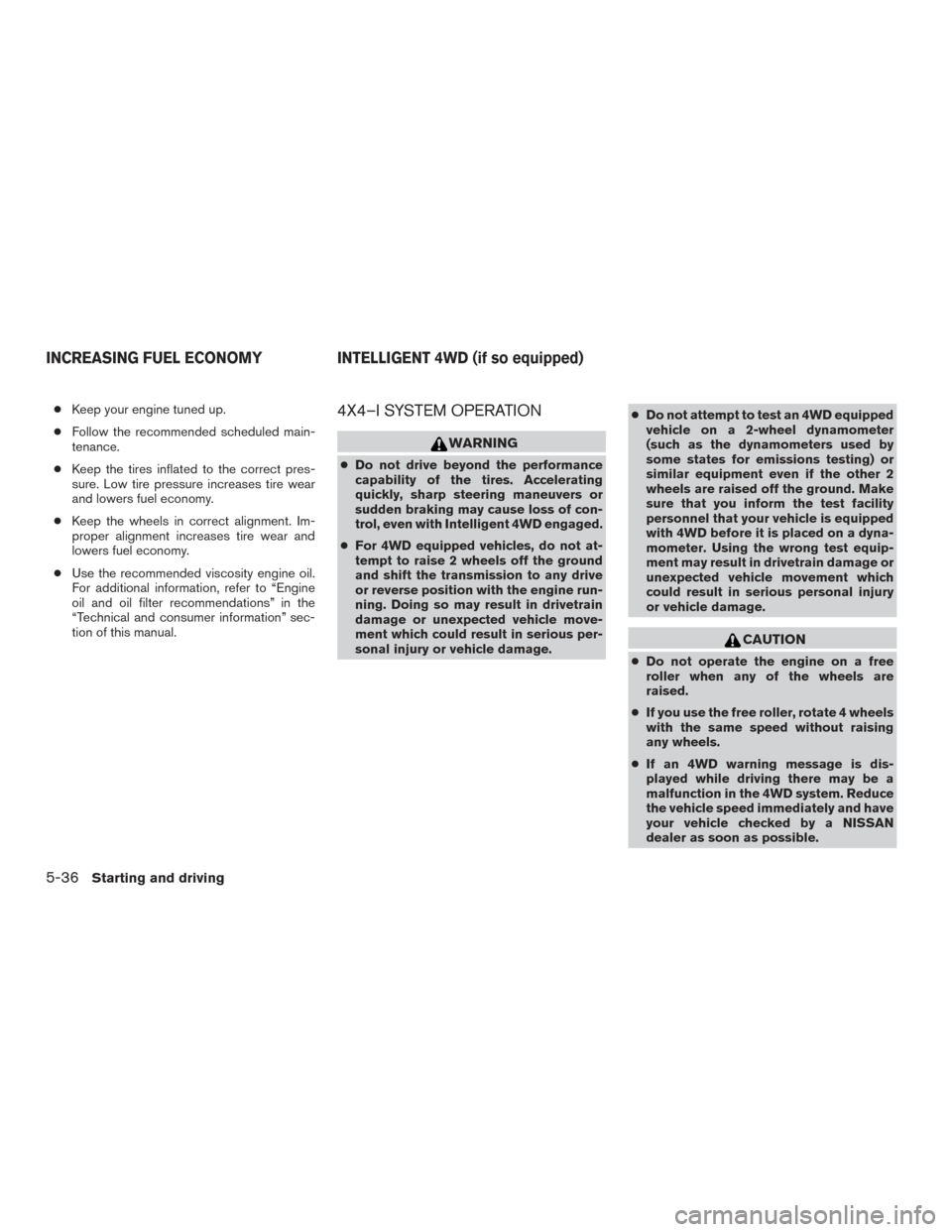
●Keep your engine tuned up.
● Follow the recommended scheduled main-
tenance.
● Keep the tires inflated to the correct pres-
sure. Low tire pressure increases tire wear
and lowers fuel economy.
● Keep the wheels in correct alignment. Im-
proper alignment increases tire wear and
lowers fuel economy.
● Use the recommended viscosity engine oil.
For additional information, refer to “Engine
oil and oil filter recommendations” in the
“Technical and consumer information” sec-
tion of this manual.4X4–I SYSTEM OPERATION
WARNING
● Do not drive beyond the performance
capability of the tires. Accelerating
quickly, sharp steering maneuvers or
sudden braking may cause loss of con-
trol, even with Intelligent 4WD engaged.
● For 4WD equipped vehicles, do not at-
tempt to raise 2 wheels off the ground
and shift the transmission to any drive
or reverse position with the engine run-
ning. Doing so may result in drivetrain
damage or unexpected vehicle move-
ment which could result in serious per-
sonal injury or vehicle damage. ●
Do not attempt to test an 4WD equipped
vehicle on a 2-wheel dynamometer
(such as the dynamometers used by
some states for emissions testing) or
similar equipment even if the other 2
wheels are raised off the ground. Make
sure that you inform the test facility
personnel that your vehicle is equipped
with 4WD before it is placed on a dyna-
mometer. Using the wrong test equip-
ment may result in drivetrain damage or
unexpected vehicle movement which
could result in serious personal injury
or vehicle damage.
CAUTION
● Do not operate the engine on a free
roller when any of the wheels are
raised.
● If you use the free roller, rotate 4 wheels
with the same speed without raising
any wheels.
● If an 4WD warning message is dis-
played while driving there may be a
malfunction in the 4WD system. Reduce
the vehicle speed immediately and have
your vehicle checked by a NISSAN
dealer as soon as possible.
INCREASING FUEL ECONOMY INTELLIGENT 4WD (if so equipped)
5-36Starting and driving
Page 412 of 506
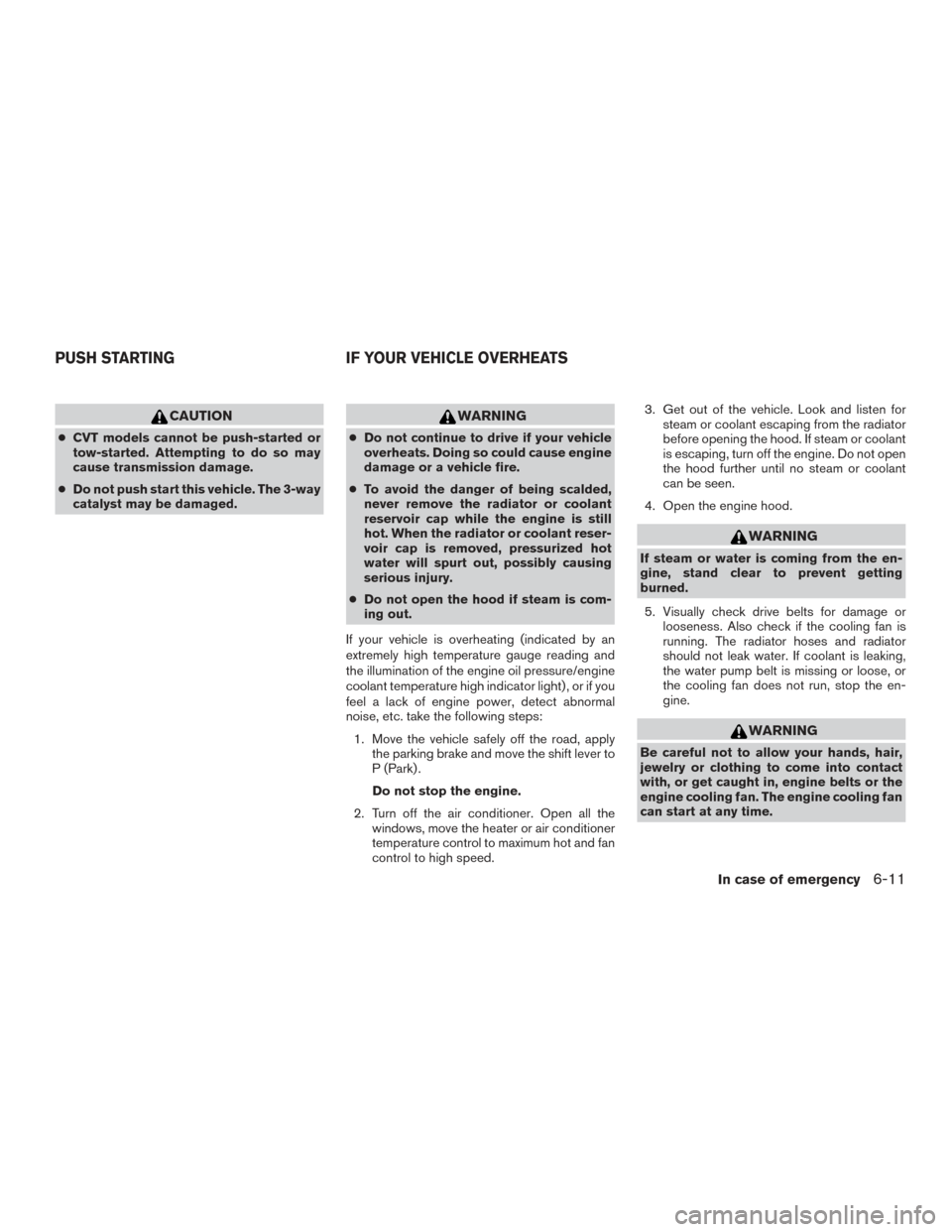
CAUTION
●CVT models cannot be push-started or
tow-started. Attempting to do so may
cause transmission damage.
● Do not push start this vehicle. The 3-way
catalyst may be damaged.
WARNING
● Do not continue to drive if your vehicle
overheats. Doing so could cause engine
damage or a vehicle fire.
● To avoid the danger of being scalded,
never remove the radiator or coolant
reservoir cap while the engine is still
hot. When the radiator or coolant reser-
voir cap is removed, pressurized hot
water will spurt out, possibly causing
serious injury.
● Do not open the hood if steam is com-
ing out.
If your vehicle is overheating (indicated by an
extremely high temperature gauge reading and
the illumination of the engine oil pressure/engine
coolant temperature high indicator light) , or if you
feel a lack of engine power, detect abnormal
noise, etc. take the following steps: 1. Move the vehicle safely off the road, apply the parking brake and move the shift lever to
P (Park) .
Do not stop the engine.
2. Turn off the air conditioner. Open all the windows, move the heater or air conditioner
temperature control to maximum hot and fan
control to high speed. 3. Get out of the vehicle. Look and listen for
steam or coolant escaping from the radiator
before opening the hood. If steam or coolant
is escaping, turn off the engine. Do not open
the hood further until no steam or coolant
can be seen.
4. Open the engine hood.
WARNING
If steam or water is coming from the en-
gine, stand clear to prevent getting
burned.
5. Visually check drive belts for damage or looseness. Also check if the cooling fan is
running. The radiator hoses and radiator
should not leak water. If coolant is leaking,
the water pump belt is missing or loose, or
the cooling fan does not run, stop the en-
gine.
WARNING
Be careful not to allow your hands, hair,
jewelry or clothing to come into contact
with, or get caught in, engine belts or the
engine cooling fan. The engine cooling fan
can start at any time.
PUSH STARTING IF YOUR VEHICLE OVERHEATS
In case of emergency6-11
Page 426 of 506
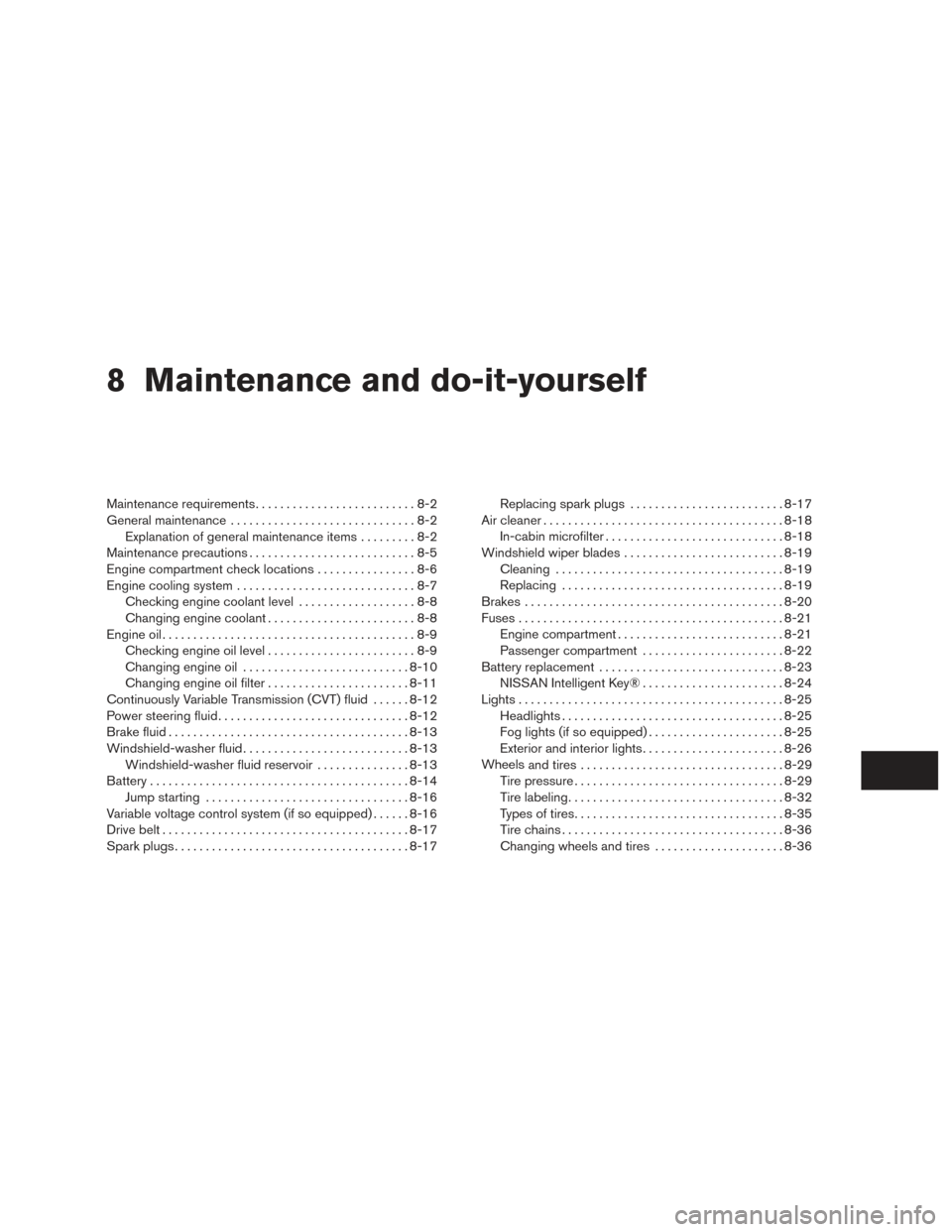
8 Maintenance and do-it-yourself
Maintenance requirements..........................8-2
General maintenance ..............................8-2
Explanation of general maintenance items .........8-2
Maintenance precautions ...........................8-5
Engine compartment check locations ................8-6
Engine cooling system .............................8-7
Checking engine coolant level ...................8-8
Changing engine coolant ........................8-8
Engine oil .........................................8-9
Checking engine oil level ........................8-9
Changing engine oil ........................... 8-10
Changing engine oil filter .......................8-11
Continuously Variable Transmission (CVT) fluid ......8-12
Power steering fluid ............................... 8-12
Brake fluid ....................................... 8-13
Windshield-washer fluid ........................... 8-13
Windshield-washer fluid reservoir ...............8-13
Battery .......................................... 8-14
Jump starting ................................. 8-16
Variable voltage control system (if so equipped) ......8-16
Drive belt ........................................ 8-17
Spark plugs ...................................... 8-17Replacing spark plugs
......................... 8-17
Air cleaner ....................................... 8-18
In-cabin microfilter ............................. 8-18
Windshield wiper blades .......................... 8-19
Cleaning ..................................... 8-19
Replacing .................................... 8-19
Brakes .......................................... 8-20
Fuses ........................................... 8-21
Engine compartment ........................... 8-21
Passenger compartment .......................8-22
Battery replacement .............................. 8-23
NISSAN Intelligent Key® .......................8-24
Lights ........................................... 8-25
Headlights .................................... 8-25
Fog lights (if so equipped) ......................8-25
Exterior and interior lights .......................8-26
Wheels
and tires ................................. 8-29
Tire pressure .................................. 8-29
Tire labeling ................................... 8-32
Types of tires .................................. 8-35
Tire chains .................................... 8-36
Changing wheels and tires .....................8-36
Page 430 of 506
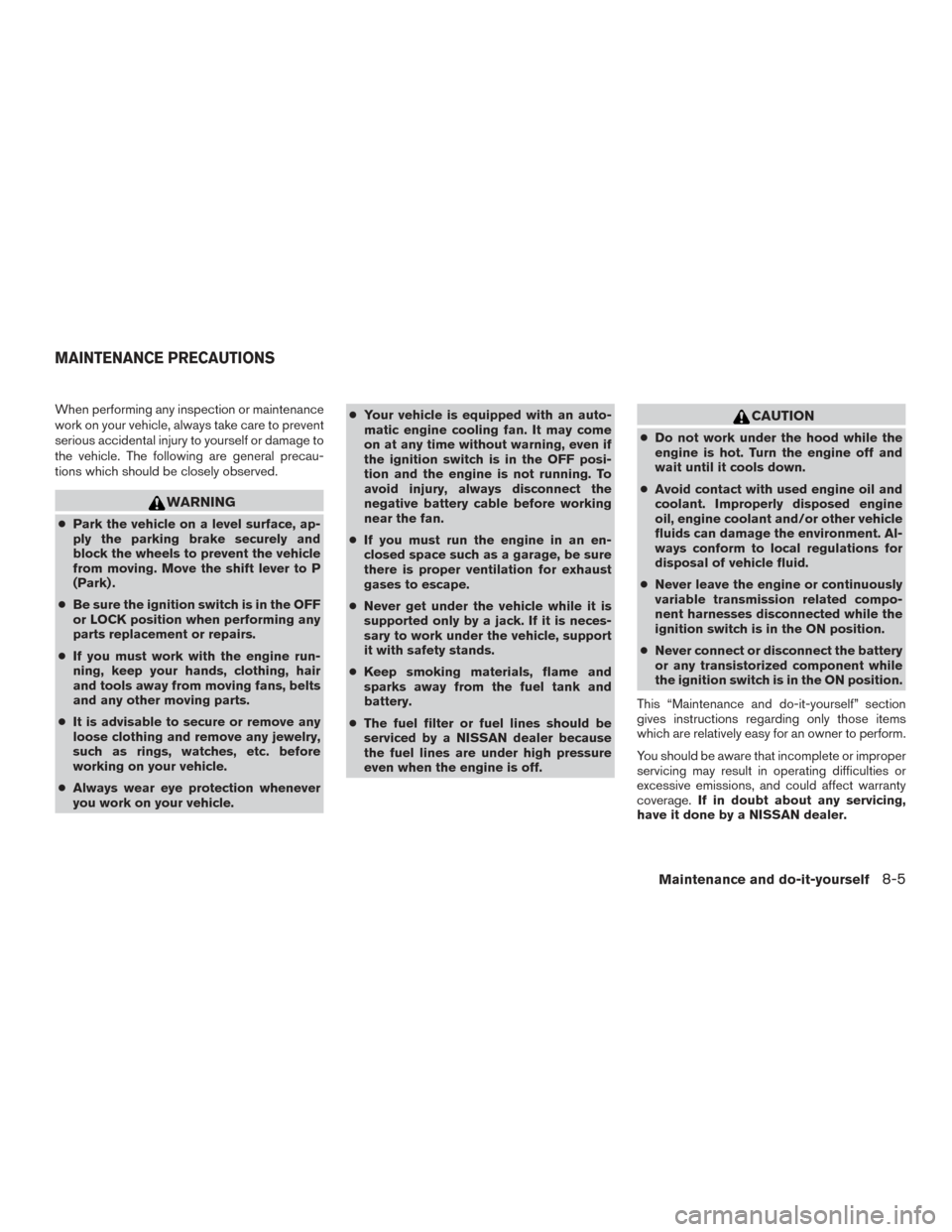
When performing any inspection or maintenance
work on your vehicle, always take care to prevent
serious accidental injury to yourself or damage to
the vehicle. The following are general precau-
tions which should be closely observed.
WARNING
●Park the vehicle on a level surface, ap-
ply the parking brake securely and
block the wheels to prevent the vehicle
from moving. Move the shift lever to P
(Park) .
● Be sure the ignition switch is in the OFF
or LOCK position when performing any
parts replacement or repairs.
● If you must work with the engine run-
ning, keep your hands, clothing, hair
and tools away from moving fans, belts
and any other moving parts.
● It is advisable to secure or remove any
loose clothing and remove any jewelry,
such as rings, watches, etc. before
working on your vehicle.
● Always wear eye protection whenever
you work on your vehicle. ●
Your vehicle is equipped with an auto-
matic engine cooling fan. It may come
on at any time without warning, even if
the ignition switch is in the OFF posi-
tion and the engine is not running. To
avoid injury, always disconnect the
negative battery cable before working
near the fan.
● If you must run the engine in an en-
closed space such as a garage, be sure
there is proper ventilation for exhaust
gases to escape.
● Never get under the vehicle while it is
supported only by a jack. If it is neces-
sary to work under the vehicle, support
it with safety stands.
● Keep smoking materials, flame and
sparks away from the fuel tank and
battery.
● The fuel filter or fuel lines should be
serviced by a NISSAN dealer because
the fuel lines are under high pressure
even when the engine is off.
CAUTION
● Do not work under the hood while the
engine is hot. Turn the engine off and
wait until it cools down.
● Avoid contact with used engine oil and
coolant. Improperly disposed engine
oil, engine coolant and/or other vehicle
fluids can damage the environment. Al-
ways conform to local regulations for
disposal of vehicle fluid.
● Never leave the engine or continuously
variable transmission related compo-
nent harnesses disconnected while the
ignition switch is in the ON position.
● Never connect or disconnect the battery
or any transistorized component while
the ignition switch is in the ON position.
This “Maintenance and do-it-yourself” section
gives instructions regarding only those items
which are relatively easy for an owner to perform.
You should be aware that incomplete or improper
servicing may result in operating difficulties or
excessive emissions, and could affect warranty
coverage. If in doubt about any servicing,
have it done by a NISSAN dealer.
MAINTENANCE PRECAUTIONS
Maintenance and do-it-yourself8-5
Page 499 of 506
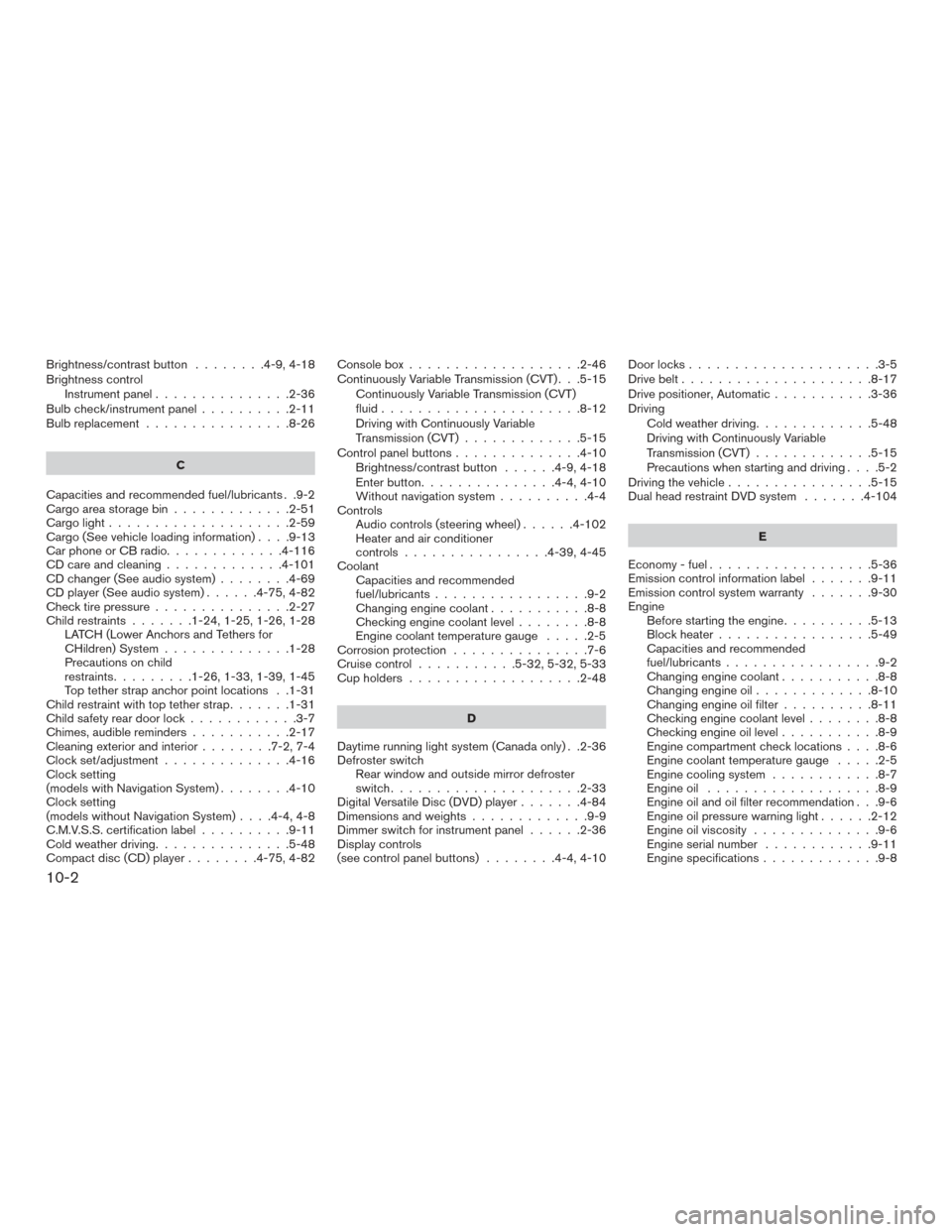
Brightness/contrastbutton ........4-9,4-18
Brightness controlInstrument panel ...............2-36
Bulb check/instrument panel ..........2-11
Bulb replacement ................8-26
C
Capacities and recommended fuel/lubricants . .9-2
Cargoareastoragebin.............2-51
Cargolight....................2-59
Cargo(Seevehicleloadinginformation)....9-13
Car phone or CB radio .............4-116
CD care and cleaning .............4-101
CD changer (See audio system) ........4-69
CD player (See audio system) ......4-75,4-82
Check tire pressure ...............2-27
Child restraints .......1-24,1-25,1-26,1-28
LATCH (Lower Anchors and Tethers for
CHildren) System ..............1-28
Precautions on child
restraints.........1-26,1-33,1-39,1-45
Top tether strap anchor point locations . .1-31
Child restraint with top tether strap .......1-31
Child safety rear door lock ............3-7
Chimes, audible reminders ...........2-17
Cleaningexteriorandinterior........7-2,7-4
Clock set/adjustment ..............4-16
Clock setting
(models with Navigation System) ........4-10
Clock setting
(models without Navigation System) ....4-4,4-8
C.M.V.S.S. certification label ..........9-11
Cold weather driving ...............5-48
Compact disc (CD) player ........4-75,4-82 Console box
...................2-46
Continuously Variable Transmission (CVT) . . .5-15 Continuously Variable Transmission (CVT)
fluid......................8-12
Driving with Continuously Variable
Transmission (CVT) .............5-15
Control panel buttons ..............4-10
Brightness/contrast button ......4-9,4-18
Enterbutton...............4-4,4-10
Without navigation system ..........4-4
Controls Audio controls (steering wheel) ......4-102
Heater and air conditioner
controls................4-39,4-45
Coolant Capacities and recommended
fuel/lubricants .................9-2
Changingenginecoolant...........8-8
Checking engine coolant level ........8-8
Engine coolant temperature gauge .....2-5
Corrosion protection ...............7-6
Cruisecontrol ...........5-32,5-32,5-33
Cupholders...................2-48
D
Daytime running light system (Canada only) . .2-36
Defroster switch Rear window and outside mirror defroster
switch.....................2-33
Digital Versatile Disc (DVD) player .......4-84
Dimensionsandweights.............9-9
Dimmer switch for instrument panel ......2-36
Display controls
(seecontrolpanelbuttons) ........4-4,4-10 Door locks
.....................3-5
Drive belt .....................8-17
Drive positioner, Automatic ...........3-36
Driving Cold weather driving .............5-48
Driving with Continuously Variable
Transmission (CVT) .............5-15
Precautions when starting and driving ....5-2
Driving the vehicle ................5-15
Dual head restraint DVD system .......4-104
E
Economy-fuel..................5-36
Emission control information label .......9-11
Emission control system warranty .......9-30
Engine Before
starting the engine ..........5-13
Blockheater.................5-49
Capacities and recommended
fuel/lubricants.................9-2
Changing engine coolant ...........8-8
Changingengineoil.............8-10
Changing engine oil filter ..........8-11
Checking engine coolant level ........8-8
Checking engine oil level ...........8-9
Engine compartment check locations ....8-6
Engine coolant temperature gauge .....2-5
Engine cooling system ............8-7
Engineoil ...................8-9
Engine oil and oil filter recommendation . . .9-6
Engine oil pressure warning light ......2-12
Engine oil viscosity ..............9-6
Engine serial number ............9-11
Engine specifications .............9-8
10-2
Page 504 of 506
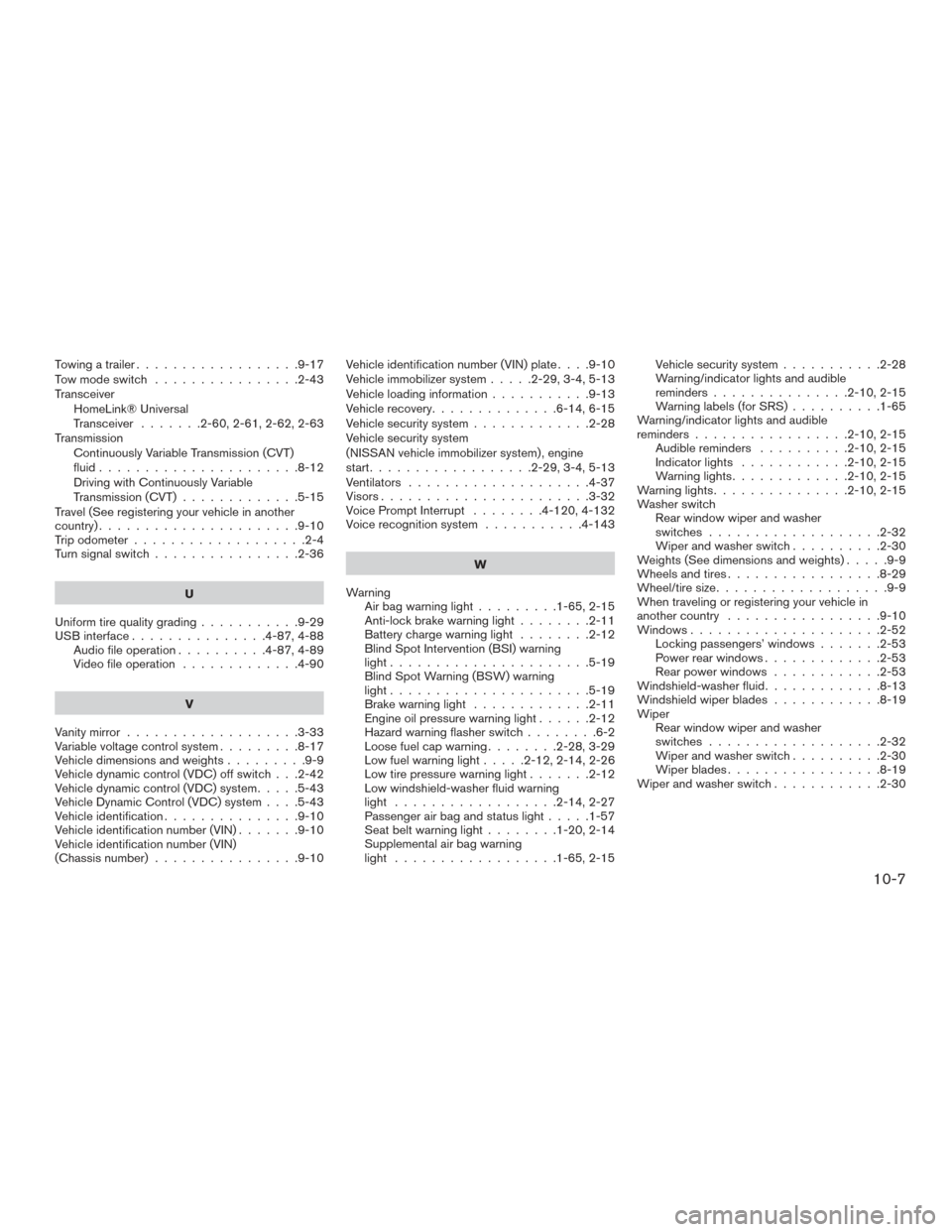
Towing a trailer..................9-17
Tow mode switch ................2-43
Transceiver HomeLink® Universal
Transceiver .......2-60,2-61,2-62,2-63
Transmission Continuously Variable Transmission (CVT)
fluid......................8-12
Driving with Continuously Variable
Transmission (CVT) .............5-15
Travel (See registering your vehicle in another
country) ......................9-10
Trip odometer ...................2-4
Turn signal switch ................2-36
U
Uniform tire quality grading ...........9-29
USB interface ...............4-87,4-88
Audio file operation ..........4-87,4-89
Video file operation .............4-90
V
Vanity mirror ...................3-33
Variable voltage control system .........8-17
Vehicledimensionsandweights.........9-9
Vehicle dynamic control (VDC) off switch . . .2-42
Vehicle dynamic control (VDC) system .....5-43
Vehicle Dynamic Control (VDC) system ....5-43
Vehicle identification ...............9-10
Vehicle identification number (VIN) .......9-10
Vehicle identification number (VIN)
(Chassis number) ................9-10 Vehicle identification number (VIN) plate
....9-10
Vehicle immobilizer system .....2-29,3-4,5-13
Vehicle loading information ...........9-13
Vehicle recovery ..............6-14,6-15
Vehicle security system .............2-28
Vehicle security system
(NISSAN vehicle immobilizer system) , engine
start ..................2-29,3-4,5-13
Ventilators ....................4-37
Visors.......................3-32
Voice Prompt Interrupt ........4-120, 4-132
Voice recognition system ...........4-143
W
Warning Airbagwarninglight.........1-65,2-15
Anti-lock brake warning light ........2-11
Battery charge warning light ........2-12
Blind Spot Intervention (BSI) warning
light......................5-19
Blind Spot Warning (BSW) warning
light......................5-19
Brake warning light .............2-11
Engine oil pressure warning light ......2-12
Hazard warning flasher switch ........6-2
Loose fuel cap warning ........2-28,3-29
Lowfuelwarninglight.....2-12,2-14,2-26
Low tire pressure warning light .......2-12
Low windshield-washer fluid warning
light ..................2-14,2-27
Passenger air bag and status light .....1-57
Seatbeltwarninglight........1-20,2-14
Supplemental air bag warning
light ..................1-65,2-15 Vehicle security system
...........2-28
Warning/indicator lights and audible
reminders ...............2-10,2-15
Warning labels (for SRS) ..........1-65
Warning/indicator lights and audible
reminders.................2-10,2-15 Audiblereminders ..........2-10,2-15
Indicatorlights ............2-10,2-15
Warning lights .............2-10,2-15
Warning lights ...............2-10,2-15
Washer switch Rear window wiper and washer
switches...................2-32
Wiperandwasherswitch..........2-30
Weights (See dimensions and weights) .....9-9
Wheels and tires .................8-29
Wheel/tire size ...................9-9
When traveling or registering your vehicle in
another country .................9-10
Windows .....................2-52
Locking
passengers’ windows .......2-53
Power rear windows .............2-53
Rear power windows ............2-53
Windshield-washerfluid.............8-13
Windshieldwiperblades............8-19
Wiper Rear window wiper and washer
switches...................2-32
Wiperandwasherswitch..........2-30
Wiperblades.................8-19
Wiper and washer switch ............2-30
10-7
Page 505 of 506
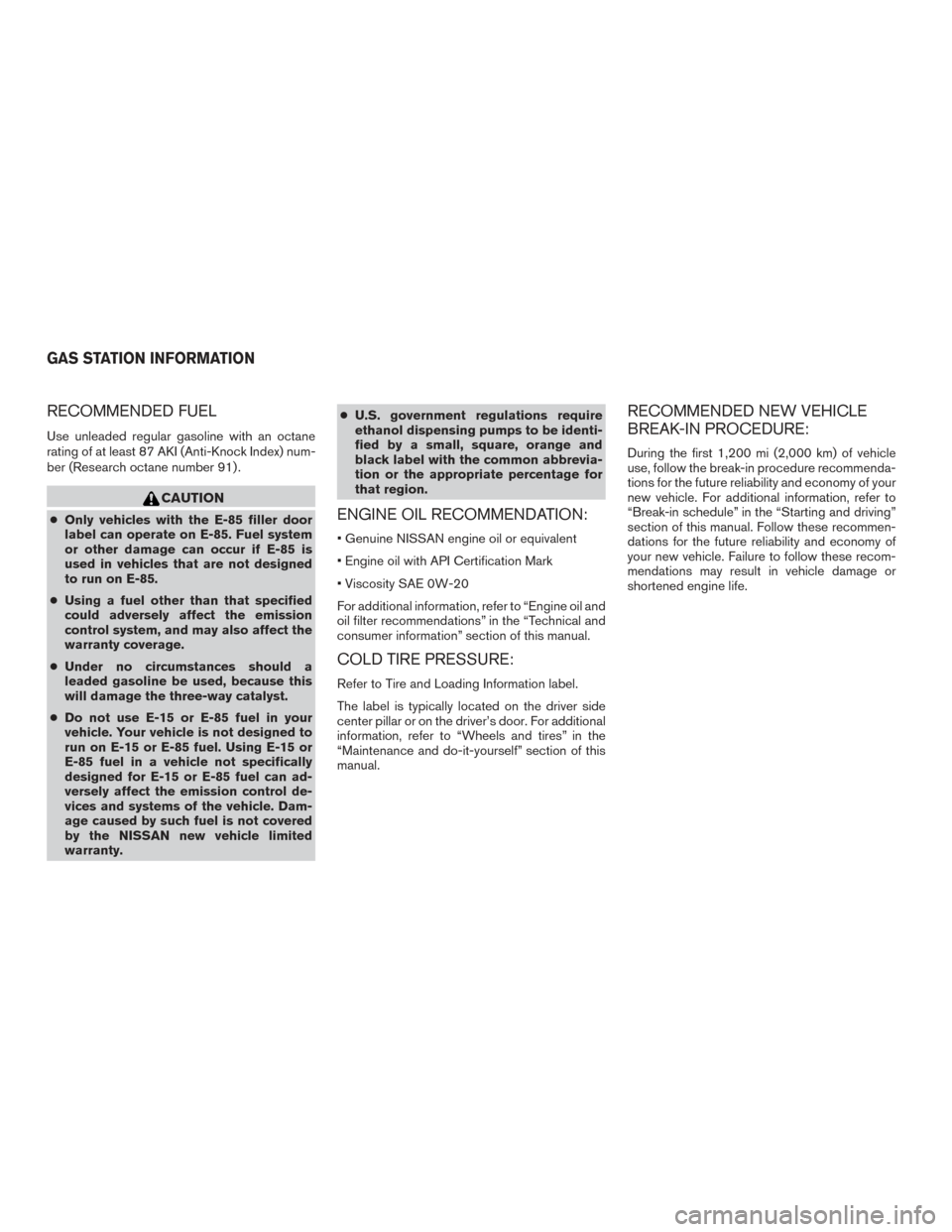
RECOMMENDED FUEL
Use unleaded regular gasoline with an octane
rating of at least 87 AKI (Anti-Knock Index) num-
ber (Research octane number 91) .
CAUTION
●Only vehicles with the E-85 filler door
label can operate on E-85. Fuel system
or other damage can occur if E-85 is
used in vehicles that are not designed
to run on E-85.
● Using a fuel other than that specified
could adversely affect the emission
control system, and may also affect the
warranty coverage.
● Under no circumstances should a
leaded gasoline be used, because this
will damage the three-way catalyst.
● Do not use E-15 or E-85 fuel in your
vehicle. Your vehicle is not designed to
run on E-15 or E-85 fuel. Using E-15 or
E-85 fuel in a vehicle not specifically
designed for E-15 or E-85 fuel can ad-
versely affect the emission control de-
vices and systems of the vehicle. Dam-
age caused by such fuel is not covered
by the NISSAN new vehicle limited
warranty. ●
U.S. government regulations require
ethanol dispensing pumps to be identi-
fied by a small, square, orange and
black label with the common abbrevia-
tion or the appropriate percentage for
that region.ENGINE OIL RECOMMENDATION:
• Genuine NISSAN engine oil or equivalent
• Engine oil with API Certification Mark
• Viscosity SAE 0W-20
For additional information, refer to “Engine oil and
oil filter recommendations” in the “Technical and
consumer information” section of this manual.
COLD TIRE PRESSURE:
Refer to Tire and Loading Information label.
The label is typically located on the driver side
center pillar or on the driver’s door. For additional
information, refer to “Wheels and tires” in the
“Maintenance and do-it-yourself” section of this
manual.
RECOMMENDED NEW VEHICLE
BREAK-IN PROCEDURE:
During the first 1,200 mi (2,000 km) of vehicle
use, follow the break-in procedure recommenda-
tions for the future reliability and economy of your
new vehicle. For additional information, refer to
“Break-in schedule” in the “Starting and driving”
section of this manual. Follow these recommen-
dations for the future reliability and economy of
your new vehicle. Failure to follow these recom-
mendations may result in vehicle damage or
shortened engine life.
GAS STATION INFORMATION